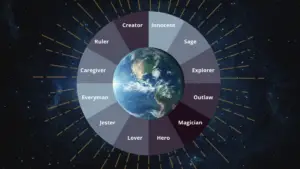Have you ever heard someone talk about a shared trait that all people of a certain kind have? They might have used the word archetype or stereotype, perhaps interchangeably. Although they sound similar, archetypes and stereotypes are actually completely different ideas altogether.
Archetypes and stereotypes focus on commonly held traits by a related group of people. However, what separates them is that stereotypes are perceived traits about real people, while archetypes are human characters and behaviors that can be found in everyone.
Stereotypes:
- Assumptions based on a generalization
Archetypes:
- A type of person, like a “jock” or “hero”.
- Universal symbols of the human psyche.
Now, let’s dive deeper into each “-type” so we can better understand their differences.
What is a stereotype?
A stereotype about someone focuses on broad, overarching, overly simple characteristics that are assumed to be possessed by all people of a group. A lot of times the group being stereotyped is a certain race, sexual orientation, national origin, religion, or social class.
This is what makes stereotypes so harmful. Anyone could be an archetype because they are human-created concepts. A stereotype describes real people in an overly generalized way.
Because stereotypes deal with real groups, they can become huge assumptions about a lot of people that don’t actually reflect all of the people in that group. If someone said that “Everyone in a certain country is violent”, they are stereotyping real people that might not actually be violent.
Pretty much every stereotype is wrong, at least part of the time. People are different, and individuals cannot be accurately characterized by groups they happen to be a part of.
What is an Archetype?
An archetype is an idea, statement or pattern that people fall into. Archetypes can be found everywhere, from movies and television, to psychology classes, and everywhere in between. Archetypes typically grow and change over time as cultures and ideas become more prominent.
Ideas about archetypes go back to ancient times (like on tarot cards) and every culture throughout space and time has them.
Learn More about the Masculine Archetypes of King Warrior Magician Lover
When we discuss archetypes we can usually fit them into two similar categories:
- Artistic archetypes – These are ideas or themes that are present throughout a work of art. Maybe you’ve read a book about someone who constantly acts like a hero in all of their actions, making them a “hero”.
- Scientific archetypes – These are certain views and expressions that people in real life hold about a variety of things in their life. Psychologists can observe people’s repeated behaviors and hypothesize “archetypes” for that person.
Differences between a Stereotype and an Archetype
As we dive deeper into archetypes and stereotypes, we can start to understand more key differences between them:
- Character versus themes – While stereotypes usually describe the behavior of an individual, archetypes can be broader concepts that relate to a bigger picture. This makes archetypes applicable in more situations. A book about a great warrior might not fit into a stereotype itself, but it could consistently display an archetype about being a warrior.
- Random judgements versus real concepts – Archetypes are everywhere, and have the potential to have a varied accuracy for everyone. Stereotypes however, usually don’t function when someone’s character is understood deeply. When you get to know a person (real or fictional) it becomes easier to see that they are individuals that vary from the norm of their stereotype.
- Help versus harm – Archetypes are used by psychological professionals and fiction writers to understand a personality more consistently. They often allow us to understand people’s deeper motivations and idiosyncrasies. Stereotypes do the opposite. Usually, they make blanket statements about people that can cloud one’s judgement about them, and create a less clear picture to understand.
- Explanation versus Observation – Archetypes can often work as explanations for every part of a character’s life. For example, an actor could figure out how their character walks by asking themselves how the character’s archetype might walk. On the contrary, stereotypes are focused on observations of someone’s specific behavior, rather than their personhood as a whole
- Consistency versus Personality – A lot of books showcase the consistency of archetypes from start to finish. Many characters find themselves fighting different parts of the same battle throughout a book. If you pick your favorite character from a book, you’ll probably find that their actions or relationships are consistent throughout the piece. They might always be the protagonist, or always fighting for a certain goal. Stereotypes rely on specific actions in specific moments. This often manifests as quick character descriptions that last a sentence or two, rather than the entire novel.
The Importance of Archetypes
Throughout history, our ancestors had legendary figures and role models to look up to. An ancient greek man might think about the god Zeus, and his ability to be bold and command situations.
Gods and legends make for fantastic archetypes because they are true to their values all the time. Stories of heroism and accomplishments by mythical heroes never change, making them a consistent “archetype” for people to follow.
Unfortunately, modern society no longer worships infallible heroes of human imagination. Instead, we look up to politicians, celebrities, and historical figures. These figures really, truly existed, which is great, except for one thing:
They’re fallible.
People make mistakes.
It seems like every day a new celebrity is ousted for their past, or a politician criticized for a painful mistake. We don’t have people to look up to anymore for strength and courage 100% of the time. An ancient Roman man could look for guidance from Mars or Jupiter, but a modern man can’t.
This is where archetypes come in. Archetypes are general “ideas” of people that we can look for to inspire and guide us. For example, what would it mean to act like the hero, or the warrior of a situation?
In Conclusion
Archetypes are a useful tool to understand deeper patterns within our own psyche, and across the human race. They are universal symbols.
Stereotypes on the other hand are gross generalizations that are usually used to dismiss people’s individuality.
It’s important to recognize this difference so you don’t perpetuate stereotypes by accident, or confuse how one might work with archetypes.
If you are interested in learning more about Archetypes, Check out the Masculine Archetype Course. The course included writing prompts, videos, and interactive activities for 7 weeks. It’s a great way to explore how Archetypes show up in your life and psyche.




